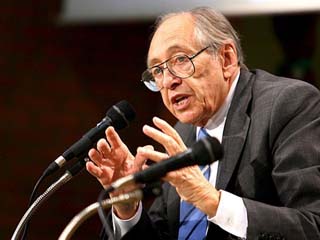Planning and Managing Distance Education Systems: Instructional Systems
By: Dr. Farhad (Fred) Saba
Founder and Editor, Distance-Educator.com
Basic Characteristics– Courses, modules, learning objects and supporting elements such as databases that include the instructional strategy and content for each subject, skill and competency that are taught and learned are the basic building blocks of these systems.
Key Personnel– Professionals who work in these systems are instructors, instructional designers, subject matter experts (SMEs) and evaluators. They work closely with those who are in the Software Systems to produce instructional materials and prepare them for students.
Impact on Other System Levels– The fact that new instructional systems have challenged the classroom instructional model that is primarily based on the lecture format is an understatement. In addition they have challenged the culture of the work of the faculty. Faculty craft each lecture at a time, and present it to their students without the assistance of an instructional designer or other support staff. As solo workers, faculty’s culture of work is pre-industrial. This is in contrast to the culture of work of the learners who are preparing themselves to work in a post-industrial society and economy. Administrators on the other hand are industrial workers. To meet the  demand of today’s mass higher education they use post industrial means, such as, the computer to provide to achieve industrial ends by creating a standardized one-size-fits-all educational experience for as many students as possible. They cannot afford nor do they strive to individualize education, as one of the major goals of the post industrial educational systems of the future.
demand of today’s mass higher education they use post industrial means, such as, the computer to provide to achieve industrial ends by creating a standardized one-size-fits-all educational experience for as many students as possible. They cannot afford nor do they strive to individualize education, as one of the major goals of the post industrial educational systems of the future.
The fact that new instructional systems have challenged the classroom instructional model that is primarily based on the lecture format is an understatement.
Students, however, know either objectively, or intuitively, that they must work in a post industrial society and economy in which industrial standardized solutions are not going to be as much in demand as situation-based context-oriented creative solutions. They, therefore, have begun to design and manage learning experiences for themselves that would provide them with the unique critical thinking and problem solving skills they need in their career. As such, they are individualizing their learning despite the craft oriented non-standard classroom learning experience, which despite its potential for and appearance of direct interaction with the instructor does not necessarily respond to their individual needs. While the administrative structure of the university compels students to move at the same pace with thousands of other students, they also are increasingly in search of alternative means and modes of education that would provide them the pacing with which they are comfortable to proceed.
A major challenge of the universities in the years to come is to synchronize these three work cultures. Offering differential staffing to departments and divisions to assist faculty and moving the culture of the faculty to post industrial work is a step in that direction. Also, moving administrative culture of the university to a future where computers are used for individualized learning experiences for each student is necessary to bring institutions of higher education to the post industrial culture.
If this synchronization takes place, not only the quality of learning would increase, but cost would come down too, as students would not be required to move forward at the same pace. Some would move forward faster, thus saving massive amounts of time. Others would move slower, however, they receive personal attention and would not waste resources in remedial education which has proved to be of little value.
Epochs of civilization; a Tofflerian analysis
NOTE: Characterizing the culture of work of the faculty, administrators and students as pre industrial, industrial and post industrial is based on the work of Alvin Toffler. This side-bar is presented to provide further information about these epochs in civilization as their understanding is important to the planning process for the future of higher education.
In The Third Wave, Alvin Toffler (1980) outlined his view of human civilization in three stages or “waves” of development, refinement and change. His analytical model is useful to assess cultures of work in higher education institutions. It is particularly important to note that these waves are not temporal, although certain points in history have marked a major shift from one to the other. In other words, in one organization, society, or country, we could see these three civilizations existing side-by-side, albeit at times in an uneasy cohabitation, as we see it in most colleges and universities. As Alvin and his wife Heidi later explained (Toffler, and Toffler, 2006) one source of conflict in contemporary business, government and educational organizations is that those who live and work by codes of each of these waves try to synchronize their work with those who work and live under the conditions of another wave, thus setting in motion the tumultuous periods of change and adjustment seen in organizations from time to time. As demonstrated in Chapter One, educational institutions are going through a time of change, and looking at them from a Tofflerian perspective will shed some light on not only the nature of the problem, but ultimately it points to some solutions as well.
The first wave- Civilization in the “first wave” was defined by agriculture. Life in the agrarian society was highly decentralized; each community relied on itself for producing goods and services, including education. There was some division of labor between the farmer and the tradesman, but workers were generalists and could accomplish their major tasks solo. If workers relied on each other at times, the work of one was not as totally dependent on the work of the others as it is in the modern factory. Synchronization, therefore, was not a major factor; it was not absolutely necessary for one job function to be synchronized with another to complete a day’s work as it became necessary later, for example, in running a railroad company or manufacturing automobile parts and assembling them on mass production belts. A general adherence to timelines was enough. Strict timetables, schedules, and deadlines were probably unheard of. The family was responsible for the education of children as well as training in farming or a trade when adulthood approached. Apprenticeship under the guidance of a close relative or friend of the family was how the young adult learned a trade. Naturally, families differed greatly in child rearing and education. Similar to many other goods and services, education was not standardized, and standardization was not the highly sought-after goal it became in the industrial age.
This longest wave in human history established itself around 8000 B.C. and lasted until the 18th century as the dominant form of social life. However, as will be demonstrated in this book, some characteristics of this wave are still visible in educational institutions in the 21st century. For example, faculty in today’s institutions of higher education working under conditions characterized by the first wave find themselves at odds with administrators who’s work has migrated into a second wave culture.
The third wave- This era began to emerge in 1955 when, for the first time, the number of white-collar workers exceeded that of factory employees in the U.S. The shift to the post industrial society had begun.
The second wave– This epoch is best characterized by industrialization when in the mid-18th century factories were established to produce goods in mass quantities. Industrial units gradually drew the population away from farming communities and centralized them in cities. Workers in modern factories had to become specialized so that most of them would do only one small but repetitive task on the assembly line. Work had to be highly synchronized for the assembly line to move smoothly. To make goods and services in large quantities as inexpensively as possible, standardization became a major goal of the industrial era. Through concentration of money in banks and other financial institutions it became possible to capitalize huge industrial works and maximize their size as well as their national and global reach.
Railroads connecting factories to sources of raw materials and markets for finished goods became the symbol of the industrial age. Centralization of command and control as well synchronization of all of the operations of an industrial unit was maximized to the point that passengers could set their timepieces by train arrivals and departures. Today, many organizations, including the administration of educational institutions, are dominated by the underlying structure of the industrial wave.
The third wave- This era began to emerge in 1955 when, for the first time, the number of white-collar workers exceeded that of factory employees in the U.S. The shift to the post industrial society had begun. The industrial civilization took only 200 years to run its course and open the way for the post industrial era. Almost all aspects of our civilization, from the mundane routines of daily life to how we shape educational institutions or elect leaders and decide on social policy, are subject to drastic changes as the third wave emerges and clashes with the vestiges of the second wave civilization in the remainder of the 21st century. In many respects the third wave is a reverse of the industrial civilization and, in certain areas, even a return to the first wave. It is impossible to depict an exact picture of how this new civilization will evolve. There are many unsettled issues at various levels, ranging from international relations to the shape of business and government organizations and their appropriate management styles, to the size and shape of the most basic human institution – the family.
Certain trends, however, have begun to emerge in anticipation of a clearer view of the future. As telecommunication becomes ubiquitous and information becomes the sought- after commodity, decentralization will accelerate in organizations, even in industrial units. It will be unnecessary to be in one place and time to work, learn, worship, or even manufacture. Synchronization will still be necessary for some industrial work, but virtualization has already given rise to asynchronous processes such as communication in distance teaching and learning. While standardization may be desirable at some level of industrial production, as will be demonstrated in this book, it will not be very useful and might even be harmful to the education of the next generation of students. The Tofflers have also suggested a reversal in specialization and concentration in certain areas. They envisage a future in which, somewhat similar to the first wave civilization, people produce what they consume in many instances. This would give rise to a new class of people they call prosumers. For example, similar to first wave families who educated their children at home, we could call today’s homeschoolers “prosumers.”
In analyzing institutions of higher education and how their role may evolve in a third wave civilization, concepts that Toffler presented provide useful analytical categories. They are listed below and will be further explored later in this book:
1- centralization,
2- specialization,
3- standardization,
4- synchronization,
5- concentration and
6- maximization.
It is important to note that Toffler’s work is an extension of what Lewis Mumford, (1934) anticipated as the post modern social transformation in the 1930s. Also, Daniel Bell, (1973) proclaimed the coming of the post industrial era. What is important in the writings of Mumford, Bell and Toffler is not only a detailed and imaginative explanation of the post industrial turn, but the description of how it impacts the way we can understand and analyze social organizations.









